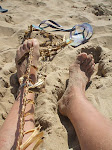After much consideration this is the title I have finally chosen for my next solo exhibition. It will be in the Shetland Museum in Lerwick for the whole of March 2016 and as the name implies, it will be about weaving and ghosts!
All the work in the show will use, in some way, materials gathered from the beaches in Shetland. Most of the materials I will be using are jetsam from international commercial fishing such as ropes, nets, crates, mussel pegs, wellies etc. Situated at the northern tip of the gulf stream, Shetland receives tons of it every year and much of which is from places as far away as Spain, France, and Canada. I have written about this stuff before as I have had a love-hate relationship with it for a long time. As a maker it is, for me, a fantastic material store but as someone who despises the profit motive because of the lack of respect it generally has for people and their environments it is also something I detest. Plus, there is way more washed up on the beaches in Shetland than I can ever use.
There has been a long standing tradition amongst mariners of 'deep
sixing' the rubbish they have on ships that they don't want to carry
around with them, but it wasn't ever really considered to be a danger to
anyone or anything when the things they were chucking overboard were biodegradeable.
The invention of polypropylene has changed all that.
This ocean trash that comes, primarily, from commercial fishing is now internationally known as 'ghost gear'. Luminously drifting phantom-like in the dark ocean, these nets and ropes trap many species. An international 'Ghost Gear Initiative' has been set up this year by the charity, World Animal Protection (formerly World Society for the Protection of Animals) which aims to draw attention to this problem through discussion, agreements and creative recycling.
But the 'Ghost' bit of my chosen title is not just about these materials, it is also about the lost tradition of basket making in the Shetland Islands. Basketry once played a critical role in survival, now there are only a handful of people who remember how these tools for life were once made. The centuries old tradition of making containers, traps, brooms, mats and chairs from indigenous natural materials died in the space of 50-60 years and by 2000 could officially be declared dead and buried. There were lots of factors that lead to this sad end, but it was irrevocable. Now for the most part the knowledge of how to effectively turn plants into functional objects is only to be discovered in museums and books. There are a few individual exceptions such as Ewen Balfour who, since the passing of Lowrie Copeland is now acknowledged as the guardian of the knowledge of kishies and their making and Ian Tait, the director of the Museum, who knows pretty much everything about the history of these items. But this was once knowledge that existed in every family in the islands because it was important to their survival.
So, the 'ghosts' are the nets and ropes and other junk, the memories of baskets that are no longer needed, and also in some way the family 'ghosts' of my grandmother Eliza Tulloch and her brothers and sisters who lived for the early part of their lives in the Haa of Midbrake, Cullivoe,Yell . I have so much respect for these people who were self sufficient but also, of necessity, courageous and strong. Sent away from the family for the first time as teenagers to go to sea or to serve as maids in places like Edinburgh, as my grandmother did, many of them never returned to live in the place they always regarded as home.
It is now my big challenge to try and amalgamate all these ideas into a coherent exhibition that I hope to tour to other venues in coastal locations where it could also have some relevance. If any of you know of any venues that you think might be appropriate please let me know.
At this stage the ideas are just starting to take shape and I know that the best way for them to develop is just to make, so I am trying to ensure that I get a few hours in the studio every day working on something even if that something ends up being a sample rather than a finished piece.
I will try to keep you posted about how the work is developing both here and on facebook.
Thursday, 14 May 2015
Subscribe to:
Post Comments (Atom)






Arrived on Shetland last night for the first time and to get my bearings went to see your show today. FANTASTIC and thank you for such thoughtful work.
ReplyDeleteThank you Anna I am very pleased you enjoyed it.I am sure you will love Shetland too.
ReplyDeleteWent to your Weaving Ghosts exhibition at Herdla Museum (Askøy, Norway) on Saturday & must just say I totally loved it, both the installations and the ideas behind it. Brilliant,
ReplyDeleteThank you very much Helen.
Delete